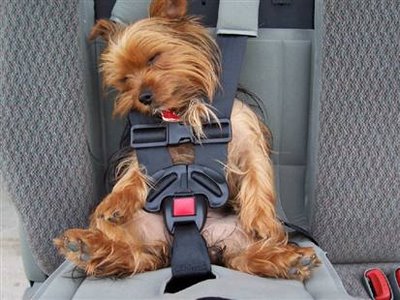Last week, The Michigan Law Firm blog informed readers about The American Humane Society's tips for driving safely with pets in the vehicle. One of the tips was to belt or restrain animals so that they can't distract the driver.
While innovations in the field of human car safety are being produced seemingly every day, pet travel safety has been largely unstudied and is lacking data in the automotive industry. However, Johnson Controls in Plymouth, Michigan tells The Detroit Free Press that they are aiming to change the way drivers travel with their pets. The company has brainstormed ideas on how to engineer seats and devices that can protect pets and their owners while riding in a vehicle.
Pet Safety Laws
Pet vehicle safety lacks guidelines and regulations since the government has yet to pass any into law. This is very concerning to the 53% of dog owners who have traveled with their pet, at least once a month, over the past year, according to a study conducted by Kurgo.
“Cars are developed for people; they aren't developed for dogs," said Lindsey Wolko, the chairman of the Center for Pet Safety in Reston, Virginia. "We have to get to the point we can have solutions that work for both. Dogs are the number 1 traveling companion, and they have little protection in the marketplace."
Pet Travel Statistics
The American Humane Society (AHS) estimates that around 100,000 dogs die in car accidents each year due to riding in truck beds. This estimate doesn’t include dogs that have jumped from vehicle windows or those that were improperly restrained - if at all - during a car collision. The number is hard to determine when most accidents involving a pet's death are rarely reported. Sadly, there are even fewer statistics and data available concerning cats and their safety and fatality rate involving car accidents.
An article in USA Today highlighted the chilling facts that most dog restraints fail. So, it comes as no surprise that a whopping 84% of dog owners do not use restraints when traveling with their dog.
Not only do most pet owners not bother with restraints, but Kurgo’s survey lists that 65% of drivers admitted to engaging in at least one distracted activity while they were driving with their pet, such as feeding them treats, trying to take a picture of the animal, or tying to pet the animal. Any of these distracted driving behaviors are serious issues when considering that a driver traveling with their pet could get into an automobile accident. Pets can be a major safety risk due since they can cause distractions leading to car accidents and since they can easily be tossed out a car and killed instantly in an accident, thereby possibly distracting other drivers on the road and causing them to get hurt too.
The Future of Pet Travel Safety
For now, Johnson Controls is still conducting their research by using pets volunteered by their employees, and observing the way pets enter and exit a vehicle and watching how they move around inside the vehicle.
“We want to understand the future of pet travel safety — and what it should look like," Wolko said. "Because of the work Johnson Controls has done with seating development in automobiles, this could lead to a whole new world of pet safety."
Wolko has pointed out the importance of supplying proper animal safety restraining devices for those motorists who travel with their pets. If pets don't have proper restraints while on the road, their owners are leaving themselves, their pets, and innocent bystanders at risk of getting into a serious auto accident. Hopefully, the public won't have to wait long for Wolko to invent or improve on restraining devices used to secure pets in vehicles. Have you or a loved one been involved in a motor vehicle collision involving a pet? Call The Michigan Law Firm, PLLC at 844. 4MI.FIRM for a free consultation today.


